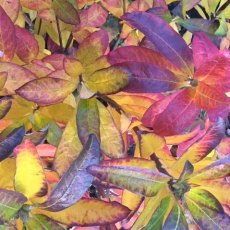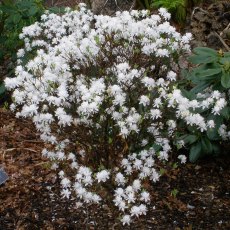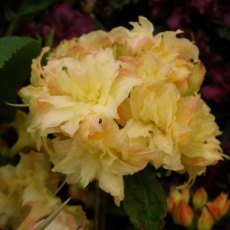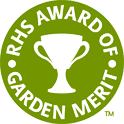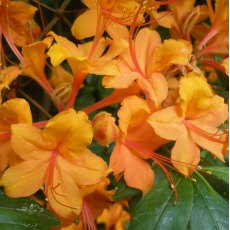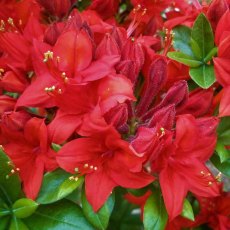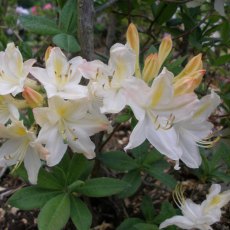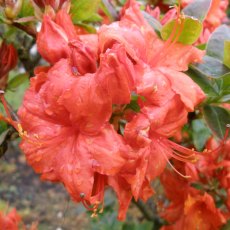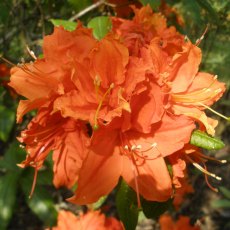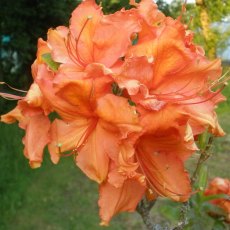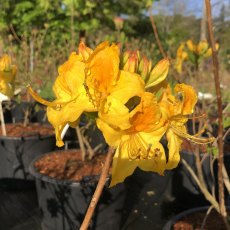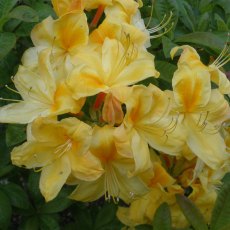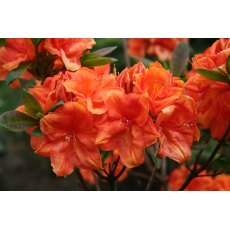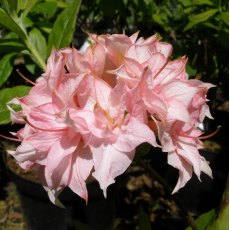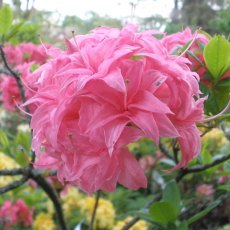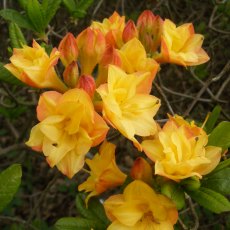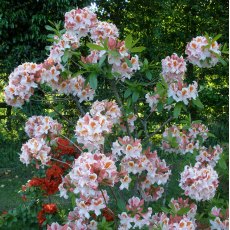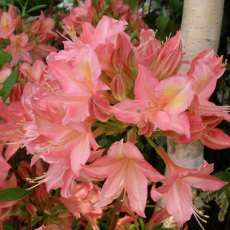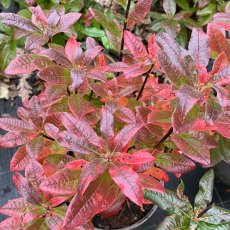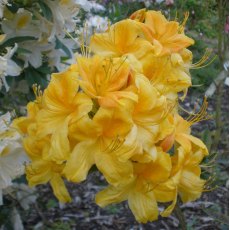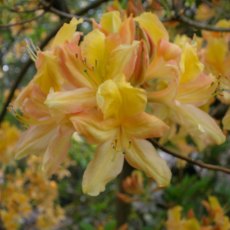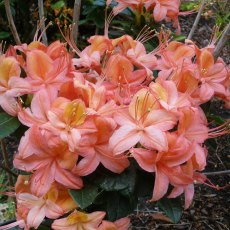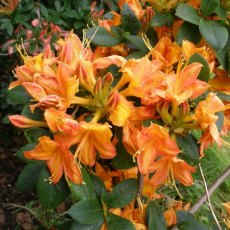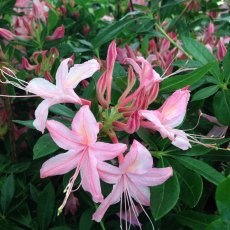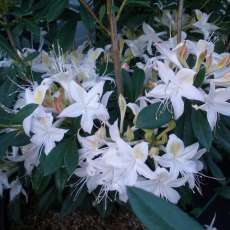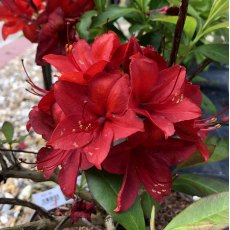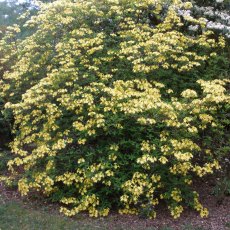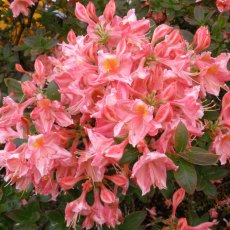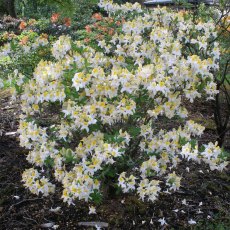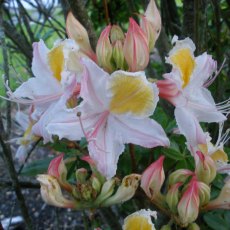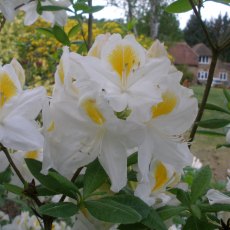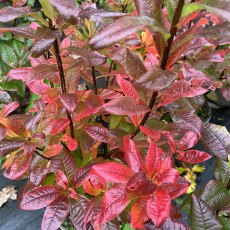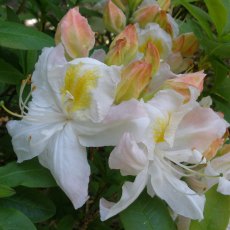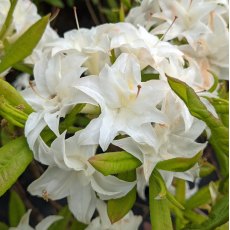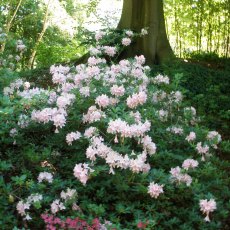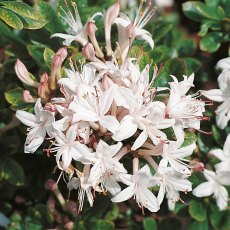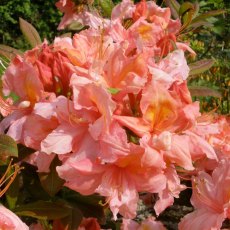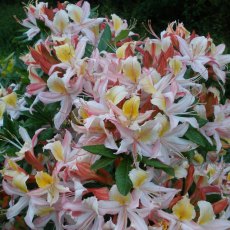Deciduous Azaleas
Deciduous Azaleas make a dazzling display, particularly in yellows and oranges. They are tough and fast growing plants typically reaching 125-150cm (4'-5') in 10 years. This selection ranges from the discreet small flowered species and Ghents, to the bold large flowering Knaphill types. Many have the added value of scent and autumn colours. While most hybrids flower towards the end of May, our newest introductions greatly extend the season into late June and July.
Deciduous Azalea Anneke
Large brilliant yellow flowers with vivid yellow spotting. The flowers are 80 to 100mm wide, 9 in each truss. Another of our favourites, this is a beautifully scented cultivar raised by Denny Pratt flowering in May-June. Height 140-160cm in 10 years. Requires a fairly sunny position.
This plant was selected as outstanding by a well-known Dutch nurseryman, Fred de Jong, and named after his daughter...
Deciduous Azalea canadense 'album'
Dainty white flowers appearing before the lovely bluish green leaves. Flowering in April-May, it is a low plant which thrives in damp conditions. It is tough with a low upright stolloniferous habit. Height 120cm in 10 years. It prefers a fairly sunny position.
Ideal for more damp conditions, flowers earlier than most.
Easy to grow.
Ideal position: damp conditions but likes some sun.
Habit: upright.
Group:...
Deciduous Azalea Cannon's Double AGM
Deep pink in bud, Cannons Double opens to stunning double light apricot pink flowers with a darker reddish pink shading on the outer petals. The flowers are up to 65mm across in trusses of 7 or 8 that flower late May and early June. It has excellent autumn foliage. Height 150cm in 10 years.
Ideal for outstanding autumn foliage.
Easy to grow.
Group: Deciduous Azalea (Exbury hybrid).
Parentage:...
Deciduous Azalea Chelsea Reach AGM
(H6) Very attractive shades of creamy yellow flowers, which are flushed pink, during mid-late May. A double flowered Ghent type azalea from the famous Knap Hill Nurseries, with wonderful red orange autumn foliage. Height 125-150cm in 10 years. Requires moist acid soils.
Bred by the late Donald Waterer.
Recommended for attractive flowers.
Easy to grow.
Group:Deciduous Azalea (Knap Hill hybrid).
Parentage:...
Deciduous Azalea Coccineum Speciosum AGM
Beautiful small orange red honeysuckle type flowers. This is a historic Ghent variety that flowers in May. Height 120 - 150cm in 10 years.
Also known as 'Coccinea Speciosa'.
Recommended for attractive flowers.
Easy to grow.
Group:Deciduous Azalea (Ghent hybrid).
Parentage: unknown
Hybridization date: pre 1900 (before 1836).
Bred by: L. Seneclause. Origin: French.
Habit: upright.
Ideal position:...
Deciduous Azalea Crosswater Red AGM
Stunning deep glowing true red flowers with contrasting stamens, flowering in late May - early June. The best red deciduous azalea which has good autumn foliage colour. Height 150-180cm in 10 years. Best in light shade.Shortly after the Second World War, and with ornamental plants in short supply, Ted Millais raised hundreds of Knaphill type seedlings to start planting his garden at Crosswater Farm....
Deciduous Azalea Daviesii AGM
Pink buds open creamy, and then change to white flowers, with a yellow blotch. Beautifully scented, the flowers are up to 65mm across in May - June. Tough and lower growing than most deciduous azaleas. Good autumn leaf colour adds extra interest. Height 120-150cm in 10 years.
Recommended for gorgeous scented flowers.
Easy to grow.
Group:Deciduous Azalea (Ghent hybrid).
Parentage:...
Deciduous Azalea Doloroso
(H6) Vivid orange-red flowers, with a paler dorsal lobe and frilly edging. Late May-early June. Flowers do not fade in sun but will last longer when dappled. Compact habit. Height 125-150cm in 10 years.
Ideal for mixed borders.
Easy to grow.
Group:Deciduous Azalea.
Parentage: Knap Hill Red x Knighthood X Cecile x Gibraltar.
Hybridization date: pre 2000 (1971), Registered 1988
Bred by: Hans...
Deciduous Azalea Fireball AGM
Stunning large deep red flowers with yellow stamens flowering in May - June. This deciduous azalea has fantastic reddish foliage, especially in autumn. Height 150-180cm in 10 years.
Recommended for wonderful foliage.
Easy to grow.
Group:Deciduous Azalea (Exbury hybrid).
Parentage: 'Scarlet Pimpernel' X 'Favor Major'
Hybridization date: pre 2000 (1951).
Bred by: E. de Rothschild. Origin: British.
Habit:...
Deciduous Azalea Fireworks
(H6) Bright orange flowers emerge from coppery-red buds in May-June. A tough upright variety, which gives extraordinary long-distant effect from a long distance. Requires moist acid soil. Height 125-150cm in 10 years.
• Recommended for bright orange flowers.• Easy to grow.• Group: Deciduous Azalea (Knap Hill hybrid).• Parentage: ‘Cecile’ X ‘Fireball’•...
Deciduous Azalea flammeum
(H5) Flame coloured flowers from orange to scarlet, long staemens and style, in rounded trusses of 6-11.
Hardy and free flowering.
Flowering time: May
From Georgia and South Carolina.
Height 125-150cm in 10 years.
Not suitable for cool summers
Easy to grow.
Group:Deciduous Azalea.
Parentage: unknown.
Habit: upright.
Ideal position: Heat and sun tolerant.
Ideal soil: pH 4.5 to 6.
RHS...
Deciduous Azalea Gibraltar AGM
A stunning plant featuring flame orange flowers with a warm yellow flare and slightly frilled petals in trusses up to 65mm across. This is a very popular deciduous azalea that flowers in May-June. Height 150-180cm in 10 years.
Recommended for attention grabbing flowers.
Easy to grow.
Group:Deciduous Azalea (Exbury hybrid)
Parentage: unknown
Hybridization date: pre 1950 (1947).
Bred by: E. de...
Deciduous Azalea Ginger
A striking plant with brilliant orange flowers with golden upper petal. It flowers about a week earlier than most Exbury type azaleas, so it's lovely in starting the Exbury azalea flowering season in mid May. Height 120-150cm in 10 years.
Ideal for mixed borders.
Easy to grow.
Group:Deciduous Azalea (Exbury hybrid).
Parentage: unknown.
Hybridization date: pre 1950 (1947).
Bred by: Exbury. Origin:...
Deciduous Azalea Golden Eagle AGM
A very pretty flower 65 - 75mm across in a domed truss of 10 to 12 flowers that is a strong reddish orange with orange yellow mid-rib and a prominent vivid orange blotch. Flowering in May-June with good bright glossy green leaves. Good autumn leaf colour adds extra interest. Height 150cm in 10 years.
Ideal for mixed borders.
Easy to grow.
Group:Deciduous Azalea (Knaphill hybrid).
Parentage:...
Deciduous Azalea Golden Nectarine
Picture owned by and supplied by Tomma, Schroeder Rhododendron
(H6) This Knaphill style flower starts off light red-orange in bud before opening to a rich golden yellowy orange with tinges of red on the edges in late May. Very similar to Sunte Nectarine but much richer in colour. Quite often the new bronze, red leaves will start to open at the same time as the flowers which gives a very nice contrast....
Deciduous Azalea Golden Oriole AGM
(H6) Clusters of golden yellow, funnel-shaped flowers with orange feathering in late April/early May. Bronze tinted young leaves, turning to mid green. Requires moist but well-drained acid soil in full sun or partial shade. Expected height and width 175-200cm in 10 years.
Deciduous Azalea Golden Sunset AGM
Lovely orange red buds open to light yellow flowers that are tinged orange, with an orange flare in the throat. Large flowers up to 65mm across in a truss of 30 flowers, appearing in late May. This plant has light green foliage slightly tinged bronze with good autumn colours. Best in a sunny position with light shade. Height 150cm in 10 years.Raised by Exbury and sold to Waterer's Nursery who introduced...
Deciduous Azalea Goldköpfchen (Gold Head)
Images owned and supplied by Schroeder Rhododendon
(H6) Beautiful, scented, star-shaped double orange flowers forming a ball shaped truss at the end of each stem in early May. Good autumn foliage colour. Height 125-150cm in 10 years. Prefers full sun/partial shade in a moist but well-drained acid soil.R. Goldköpfchen, translates to Gold Head.
Deciduous Azalea Helena Evelyn
(H6) Rich sugar pink 'Homebush' hybrid. Grows best in light dappled shade or full sun. This is a doubled flowered plant of excellent quality and a lovely shade of pink. Height 150cm in 10 years.
One of 4 lovely 'Homebush' hybrids bred by noted New Forest Azalea breeder George Hyde, who bred the Solent strain of Azaleas for Exbury Gardens. We have propagated these exclusively from the garden of his...
Deciduous Azalea Homebush AGM
Extremely attractive double deep carmine pink flowers in a ball-shaped pompom-like truss 30mm across. Flowering May - June this deciduous azalea has good autumn colour. Height 120-150cm in 10 years. Requires a fairly sunny position.
Recommended for attractive flowers and autumn leaf colour.
Easy to grow.
Group:Deciduous Azalea (Knaphill hybrid).
Parentage: unknown
Hybridization date: pre 1950...
Deciduous Azalea Imago
Lovely deep yellow double flowers, tinged purplish red flowering in late May. One of Donald Waterer's later hybrids but still rare. Height 150cm in 10 years.
Recommended gorgeous flowers.
Easy to grow.
Group:Deciduous Azalea (Knaphill hybrid).
Parentage: unknown.
Hybridization date: pre 2000 (1959).
Bred by: Waterer (Bagshot). Origin: British.
Habit: compact.
Ideal position: Most sunny garden...
Deciduous Azalea Jock Brydon AGM
Striking pinky white flowers with a bold speckled reddish orange blotch and wavy ruffled edges. A stunning occidentale hybrid with a good scent in May and June. This is vigorous as a young plant with arching branches. Height 150-180cm in 10 years.
Recommended for striking scented flowers.
Easy to grow.
Group:Deciduous Azalea (Occidentale hybrid).
Parentage: molle subsp. molle X occidentale.
Hybridization...
Deciduous Azalea Jolie Madame AGM
Fine pink trumpet shaped scented flowers with an orange yellow blotch up to 70mm across on a truss of 7 to 9 flowers. Flowering in May - June with an upright habit it also has lovely autumn colour. Height 140-160cm after 10 years.
Recommended for lovely fragrance.
Easy to grow.
Group:Deciduous Azalea (viscosum hybrid).
Parentage: viscosum x 'Koster's Brilliant Red' X 'Satan'.
Hybridization date:...
Deciduous Azalea Juniduft
Image supplied and owned by H. Hachmann https://www.hachmann.de/
(H6) Sweetly scented stunning two tone pale pink funnel shaped flowers, that have a wonderful yellow spotted upper lobe, appear in late May early June. The new growth come through bronze in colour and turns deep green as the season progresses. Height 125-150cm in ten years.
• Recommended for: Gorgeous scented flowers.• Easy...
Deciduous Azalea Karminduft
(H6) Carmine red scented flowers with an orangey tone in the centre. May-June flowering. Scented red azaleas are rare, so this tough viscosum hybrid bred by Hans Hachmann in Germany is a bonus. Height 150-175cm in 10 years.
Name translates to 'Scented Carmine'.
• Recommended for large fragrant flowers.• Easy to grow.• Group:Deciduous Azalea (viscosum hybrid)• Parentage: unknown.•...
Deciduous Azalea Klondyke AGM
Red orange in bud opening to one of the best bright golden yellow flowers in May - June. This fine deciduous azalea has coppery red new growth and good autumn colour. Height 150-180cm in 10 years. Requires a fairly sunny position.
Recommended for one of the best yellow flowers.
Easy to grow.
Group:Deciduous Azalea (Exbury hybrid).
Parentage: unknown
Hybridization date: pre 1950 (1947).
Bred...
Deciduous Azalea Knaphill Apricot
Extremely attractive large apricot yellow flowers in early to mid May. This plant is an unusual colour which always attracts interest. Height 150-180cm in years. Requires a fairly sunny position.
Recommended for lovely flowers.
Easy to grow.
Group:Deciduous Azalea (Knaphill hybrid).
Parentage: unknown.
Hybridization date: pre 2000 (1950).
Bred by: Waterer (Bagshot). Origin: British.
Habit:...
Deciduous Azalea Midsummer Coral
(H6) Stunning scented coral pink flowers with a prominent yellow orange flare. Raised by Ted Millais at Crosswater Farm, particularly to extend the flowering season. Flowering in late June with lovely light green foliage. Height 125-150cm in 10 years.
This lovely plant is as a result of the breeding work Ted did with Denny Pratt's later flowering azaleas. Denny specialised in breeding late flowering...
Deciduous Azalea Midsummer Glow
(H6) Orange red bubs open to scented glowing orange flowers shading to yellow orange stripes and a golden flare on the upper lobe. Flowering in June and part of the ‘Midsummer’ range, bred and raised here at our nursery.
This lovely plant is as a result of the breeding work Ted did with Denny Pratt's later flowering azaleas. Denny specialised in breeding late flowering azaleas during the...
Deciduous Azalea Midsummer Star
(H6) Beautifully scented bright pink narrow tubular star-shaped flowers. Raised by Ted Millais at Crosswater Farm, particularly to extend the flowering season. Flowering in late June with nice glossy foliage. Height 125-150cm in 10 years.
This lovely plant is as a result of the breeding work Ted did with Denny Pratt's later flowering azaleas. Denny specialised in breeding late flowering azaleas during...
Deciduous Azalea Midsummer Wedding
Pale apricot buds, open to beautiful scented white flowers with pale yellow markings on the upper lobe. Raised by Ted Millais at Crosswater Farm, particularly to extend the flowering season. Flowering in late June with lovely reddish new growth and glaucous shiny leaves. Height 125-150cm in 10 years.
This lovely plant is as a result of the breeding work Ted did with Denny Pratt's later flowering azaleas....
Deciduous Azalea Nabucco
(H6) Beautiful dark red flowers with a flare of vivid reddish orange, and contrasting yellow anthers. An excellent and very hardy introduction from Hachmann's Nursery in Northern Germany. Flowering in late May to early June. Height 150-175cm in 10 years.
• Recommended for striking flowers.• Easy to grow.• Group: Deciduous Azalea.• Parentage: ‘Betty Kelly’ X ‘Feuerwerk’.•...
Deciduous Azalea Narcissiflorum AGM
Lovely small pale yellow flowers, with darker centre and outside, 30mm across. Sweetly scented double honeysuckle type flowers in May - June, followed by good autumn colour and one of David's recommended varieties. This is an unusual but highly sought after plant which is one of our specialities. Height 150-180cm in 10 years.
Recommended for amazing scented flowers.
Easy to grow.
Group:Deciduous...
Deciduous Azalea Niamh
(H6) Wonderful large deep pink flowers with a prominent orange-yellow flare on the upper petal, in late May. Stunning red foliage develops through the summer. Height is 150cm in 10 years. It does require a fairly sunny position.
This is a lovely plant which was bred by Ted Millais, and always attracted attention in the garden with its deep pink flowers, set off by lovely red foliage. For years we...
Deciduous Azalea Nicholas de Rothschild
(H5) A wonderful bicoloured double flower, which is red in tight bud, opening through deep pink to deep golden yellow, turning to soft pink and apricot as they mature. May. Deep green foliage turns fiery red in autumn before falling. Height 125-150cm in 10 years with an upright habit.
This combination makes for a kaleidoscope of colour through the spring. Altogether a great shrub for punctuating...
Deciduous Azalea Northern Hi Lights
Yellow buds open in May to beautiful creamy white scented flowers with a prominent bright yellow upper lobe giving a two tone effect. Gorgeous autumn colours. Bred at the University of Minnesota in North America, so it is exceptionally hardy. Height 120 - 150cm in 10 years. Requires a fairly sunny position.
Recommended for beautiful scented flowers.
Easy to grow.
Group:Deciduous Azalea (Northern...
Deciduous Azalea occidentale (Palomar 402)
A wonderful sweet-scented June flowering azalea with large white and pink flowers and an orange blotch. It has good autumn foliage colours. Selected from the best plants in Oregon and California, this is a stunning plant. Height 120-150cm in 10 years.
occidentale has been used in the development of many beautiful scented deciduous azalea hybrids, but can be prone to mildew towards the end of the summer,...
Deciduous Azalea Persil AGM
Stunning large pure white flowers with a prominent deep yellow flare in the throat. Flowering in mid-late May this is one of our favourites. A striking Knaphill azalea. Height 120-150cm in 10 years.
Easy to grow.
Group:Deciduous Azalea (Knaphill hybrid).
Parentage: unknown.
Hybridization date: pre 1950 (before 1926).
Bred by: Waterer (Knap Hill). Origin: British.
Habit: upright.
Ideal position:...
Deciduous Azalea Rumba
(H6) This deciduous azalea has bright vivid orange flowers which start to open in May and continue well into June helping to extend the flowering season for the orange deciduous azaleas.The new leaves emerge green with a red hue around the margins before turning golden orange and crimson red in the autumn months. This plant grows to be around 1.5m high and 1.2m wide and prefers to be in a sunny spot.
•...
Deciduous Azalea Satan AGM
Wickedly dark red in bud, opening to large deep orange-red flowers in late May and early June. A good mildew resistant plant raised by the old Waterer Nurseries at Knaphill, and introduced by W C Slocock Ltd. This variety makes a real statement and is a must for any garden. Height 150-175cm in 10 years.
Recommended for stunning flowers.
Easy to grow.
Group:Deciduous Azalea (Knaphill hybrid).
Parentage:...
Deciduous Azalea Silver Slipper AGM
Pink buds open to large white flowers with a prominent yellow orange flare in May - June. A stunning deciduous azalea that has good coppery autumn colour. Height 150-180cm in 10 years. Prefers a fairly sunny position.
Easy to grow.
Group:Deciduous Azalea (Exbury hybrid).
Parentage: unknown
Hybridization date: pre 1950 (1948).
Bred by: Exbury. Origin: British.
Habit: compact.
Ideal position:...
Deciduous Azalea Snow's Head
(H6) Almost pure white star shaped double flowers, forming large white balls of sweetly scented flowers in early May. Each flower is between 35 – 45mm and all the stamens are petaloid, adding more floral impact. This plant has lush bright green foliage and a broadly upright habit. Height 125-150cm in 10 years.A stunning plant bred and registered in Germany by top rhododendron breeder Holger Hachmann...
Deciduous Azalea Soft Lights
(H6) Rich pink in bud, opening to enormous double blooms of pastel pink and shades of soft cream. This gives a variable two tone effect in late May with different colours on different flowers. An outstanding introduction from New Zealand. Best in light shade. Height 150-175cm in 10 years.
Raised by Denis Hughes, a noted rhododendron breeder from Blue Mountain Nurseries, in the South of New Zealand....
Deciduous Azalea Soir de Paris AGM
Delicate and scented purplish pink flowers with an orange blotch and darker lines. Flowering in June, the flowers are up to 50mm in trusses of 7 to 9. An excellent plant with pretty small greyish/blue leaves. Height 120-150cm in 10 years. It prefers a fairly sunny position.
Recommended for pretty scented flowers.
Easy to grow.
Group:Deciduous Azalea (viscosum hybrid).
Parentage: viscosum X 'Koster's...
Deciduous Azalea Sommerduft (Summer Scent)
Picture owned by and supplied by Tomma, Schroeder Rhododendron
(H6) Stunning almost pure white trumpet-shaped flowers with a very faint pink tinge to the outer edges opening in July typically after the foliage has appeared. The flowers are strongly scented which comes from azalea viscosum which makes up most of this plant’s parentage. The leaves are soft green in colour. The plant itself has...
Deciduous Azalea Strawberry Ice AGM
Lovely deep pink in bud opening to mid pink flowers with a golden flare, fading lighter over time. Flowering in large trusses of 23 flowers up to 70mm across in May - June. It has bronzy young growth with good autumn colour. Height 150-180cm in 10 years.
Ideal for mixed borders.
Easy to grow.
Group:Deciduous Azalea (Exbury hybrid).
Parentage: unknown.
Hybridization date: pre 1950 (1947).
Bred...
Deciduous Azalea Summer Sorbet
Stunning salmon pink buds open to very pale pink fragrant flowers with a lemon yellow flare on the upper lobe. Late June flowering to extend the flowering season. Best in light shade. Height 125-150cm in 10 years.
Another Denny Pratt hybrid that was collect by Ted Millais from Dunham Massey National Trust garden where it was labelled 'DP121A'.
Recommended for beautiful late scented flowers.
Easy...
Deciduous Azalea Sun Star
(H6) Glowing dark salmon pink in bud, opening with bright yellow double fragrant flowers, and changing to soft orange in late May. It is a really bright glowing flower, which is followed with good autumn foliage colour. A choice hybrid from Tijs Huisman in Holland. Height 150-175cm in 10 years.
Tijs developed this plant by crossing some seedlings made by Fred Minch in USA with R. luteum. Previously...
 Millais Nurseries
Millais Nurseries


